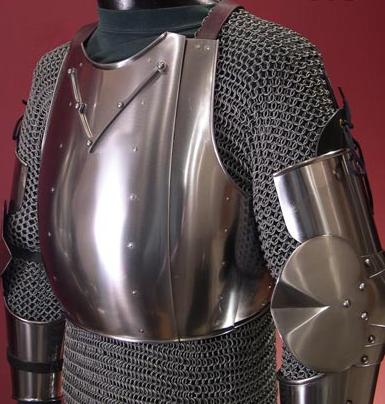| Author |
Message |
|
Andrew Mejia
|
 Posted: Tue 04 Aug, 2009 1:52 pm Post subject: Has anyone ever heard of a Globose breastplate? Posted: Tue 04 Aug, 2009 1:52 pm Post subject: Has anyone ever heard of a Globose breastplate? |
 |
|
|
Hello I'm Andrew I recently been involved in 14th century reenacting and I'm gonna buy a breast plate soon. From a good friend of mine i've heard there is a european breastplate that has additional plates or peice that wrap around the back just under the ribs of the lower back. He said it was called a globose but all my searches have brought up nothing. maybe I'm spelling it wrong or simply i am wrong. Anyone know what i'm talking about?
|
|
  |
 |
Gavin Kisebach

|
 Posted: Tue 04 Aug, 2009 2:28 pm Post subject: Posted: Tue 04 Aug, 2009 2:28 pm Post subject: |
 |
|
Here's what I've got; I don't know the source of the images but I have seen people use these in SCA combat. They look to be a good balance of protection and mobility. They also work better for fighters with a bit of "prosperity" around the middle.
 Attachment: 32.33 KB Attachment: 32.33 KB

There are only two kinds of scholars; those who love ideas and those who hate them. ~ Emile Chartier
|
|
   |
 |
D. Austin
Industry Professional

Location: Melbourne, Australia Joined: 20 Sep 2007
Posts: 208
|
 Posted: Tue 04 Aug, 2009 3:53 pm Post subject: Posted: Tue 04 Aug, 2009 3:53 pm Post subject: |
 |
|
Hi Andrew,
Try a search here on myArmoury or on your favourite search engine for Churburg #13. This is perhaps the most famous of globose breastplates with the wrap-around back.
Darren.
|
|
  |
 |
Steven H

|
 Posted: Tue 04 Aug, 2009 7:17 pm Post subject: Posted: Tue 04 Aug, 2009 7:17 pm Post subject: |
 |
|
Hello,
Globose refers to the shape of the front of the breast plate - curved outward. It creates a stronger shape and produces glancing surfaces.
All breastplates possess this to one degree or another; it makes them so much more effective then a flat piece of steel. Although there are odd variations like peascod and kastenbrust styles.
The particular style you describe is the Churburg #13. I've seen it referred to as a segmented breastplate. It seems to be an evolutionary step between the Coat of Plates and the proper Breastplate. I'm not aware of any other examples of that particular style besides the piece in the Churburg Armoury. So I believe it to be uncommon (but I'm not certain).
Cheers,
Steven
Kunstbruder - Boston area Historical Combat Study
|
|
   |
 |
|
Andrew Mejia
|
 Posted: Sat 15 Aug, 2009 5:19 am Post subject: Posted: Sat 15 Aug, 2009 5:19 am Post subject: |
 |
|
|
Alright thanks alot guys that was exactly the information I needed
|
|
  |
 |
Christian Henry Tobler

Location: Oxford, CT Joined: 25 Aug 2003
Posts: 704
|
 Posted: Sat 15 Aug, 2009 9:08 am Post subject: Posted: Sat 15 Aug, 2009 9:08 am Post subject: |
 |
|
Hi Steven,
That has been the conventional wisdom: that the #13 is a rarity or one-off.
However, there are a number of seeming variations on this theme shown in two of the 'Gladiatoria Group' of combat treatises, both c. 1430, and in a religious manuscript, almost certainly from the same art shop/school, also c. 1430.
At this latter date, they're shown with faulds.
Given the paucity of surviving torso defenses from the 14th c., we need to look farther afield to find this stuff.
Cheers,
Christian
Christian Henry Tobler
Order of Selohaar
Freelance Academy Press: Books on Western Martial Arts and Historical Swordsmanship
Author, In Saint George's Name: An Anthology of Medieval German Fighting Arts
|
|
    |
 |
Steven H

|
 Posted: Sat 15 Aug, 2009 1:28 pm Post subject: Posted: Sat 15 Aug, 2009 1:28 pm Post subject: |
 |
|
| Christian Henry Tobler wrote: |
However, there are a number of seeming variations on this theme shown in two of the 'Gladiatoria Group' of combat treatises, both c. 1430, and in a religious manuscript, almost certainly from the same art shop/school, also c. 1430.
At this latter date, they're shown with faulds.
|
Thanks for the info. Could you point me to a picture of this?
Cheers,
Steven
Kunstbruder - Boston area Historical Combat Study
|
|
   |
 |
David E. Farrell

Location: Evanston, IL Joined: 25 Jun 2007
Posts: 156
|
 Posted: Sun 16 Aug, 2009 4:19 am Post subject: Posted: Sun 16 Aug, 2009 4:19 am Post subject: |
 |
|
| Gavin Kisebach wrote: | | They also work better for fighters with a bit of "prosperity" around the middle. |
In those cases, the breastplate fit is sometimes somewhat incorrect... the bottom usually comes to about the bottom of the floating ribs (at least in the late 14th C / early 15th C italian and german syles) - not so far down as the waist. Though I believe the much later Peascod styles did.
AKA: 'Sparky' (so I don't need to explain later  ) )
For he today that sheds his blood with me shall be my brother
-- King Henry, Henry V, William Shakespeare
Before I came here I was confused about this subject. Having listened to your lecture I am still confused... but on a higher level.
-- Enrico Fermi
|
|
  |
 |
|
|

